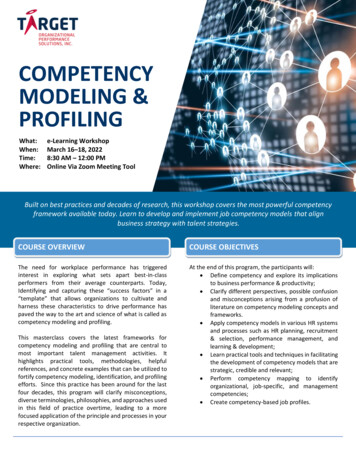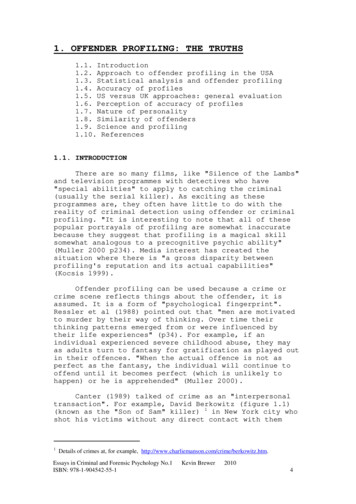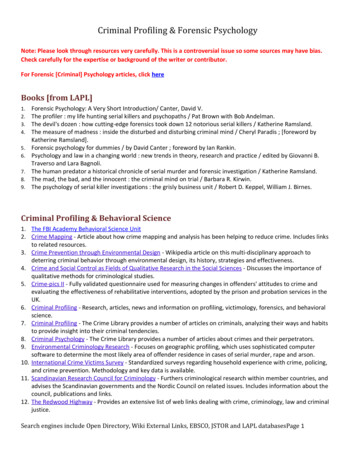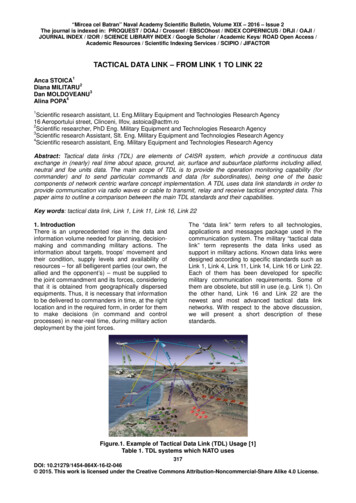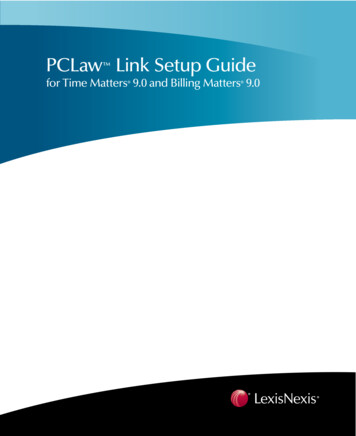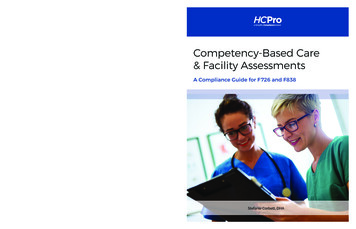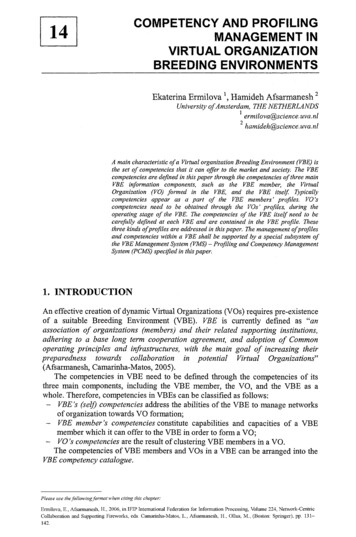
Transcription
COMPETENCY AND PROFILINGMANAGEMENT INVIRTUAL ORGANIZATIONBREEDING ENVIRONMENTSEkaterina Ermilova ', Hamideh Afsarmanesh University of ideh@science.uva.nlA main characteristic of a Virtual organization Breeding Environment (VBE) isthe set of competencies that it can offer to the market and society. The VBEcompetencies are defined in this paper through the competencies of three mainVBE information components, such as the VBE member, the VirtualOrganization (VO) formed in the VBE, and the VBE itself. Typicallycompetencies appear as a part of the VBE members' profiles. VO'scompetencies need to be obtained through the VOs' profiles, during theoperating stage of the VBE. The competencies of the VBE itself need to becarefully defined at each VBE and are contained in the VBE profile. Thesethree kinds ofprofiles are addressed in this paper. The management of profilesand competencies within a VBE shall be supported by a special subsystem ofthe VBE Management System (VMS) - Profiling and Competency ManagementSystem (PCMS) specified in this paper.1. INTRODUCTIONAn effective creation of dynamic Virtual Organizations (VOs) requires pre-existenceof a suitable Breeding Environment (VBE). VBE is currently defined as "a«association of organizations (members) and their related supporting institutions,adhering to a base long term cooperation agreement, and adoption of Commonoperating principles and infrastructures, with the main goal of increasing theirpreparedness towards collaboration in potential Virtual Organizations"(Afsarmanesh, Camarinha-Matos, 2005).The competencies in VBE need to be defined through the competencies of itsthree main components, including the VBE member, the VO, and the VBE as awhole. Therefore, competencies in VBEs can be classified as follows:- VBE's (self) competencies address the abilities of the VBE to manage networksof organization towards VO formation;- VBE member's competencies constitute capabilities and capacities of a VBEmember which it can offer to the VBE in order to form a VO;- VO's competencies are the result of clustering VBE members in a VO.The competencies of VBE members and VOs in a VBE can be arranged into theVBE competency catalogue.Please use the following formatwhenciting this chapter:Ermilova. E. Afsarmanesh. H. 2006. in IFIP International Federation for Information Processing, Volume 224. Network-CentricCollaboration and Supporting Fireworks, eds. Camarinha-Matos, L., Afsarmanesh, H., Ollus, M., (Boston: Springer), pp. 1 3 1 142,
13 2NETWORK-CENTRIC COLLABORA TIONOriginally competencies are a part of the profiles. In general, an organizationalprofile can be defined as a set of structured information about the organization. VBEhas three types of profiles including VBE member's profile, VO's profile, and VBE's(self) profile.This paper specifies common models for competencies and profiles, andaddresses a Profiling and Competency Management System (PCMS) whichconstitutes an important part of the VBE Management System (VMS).Chapter 2 of this paper addresses the studied state of the art inclvi&mg,firsttheliterature study on competency models, second the study of existing systems fororganization profiling, third the study of profiling and competency management inexisting VBEs, and fourth the experts' requirements to the PCMS.Chapter 3 addresses the specification of the PCMS's components and functions.This work on this paper was supported in part by the FP6 IP project, calledECOLEAD, funded by the European Commission.2. STATE OF THE ARTIn order to define the elements of the competencies and profiles of the VBE (self),the VBE member, and the VO, as well as to model the PCMS for VBEs, the stateof-the-art related to profiling and competency of organizations is studied.In this chapter, a summary of some of the state of art work in this area as well asthe results of some case studies that we have performed to identify the mainrequirements for the PCMS, as expressed by the field experts and academic experts,are presented.2.1 Literature study of competency modelsIn the literature, different authors propose different definitions for competencies oforganizations (companies), with some commonality (Galeano, Ermilova at al, 2006).Two of these definitions closer to our definition of competency are addressed below.Javidan (Javidan, 1998) defines the competency hierarchy as depicted inFigure 1. According to Javidan, resources are the inputs into the organization'svalue chain. Javidan categorizes resources into three groups of physical resources(e.g. equipment, location and assets), human resources (e.g. manpower, managementteam, training and experience) and organizational resources (e.g. culture andreputation). Capabilities refer to the organization's ability to exploit its resources;they consist of a series of business processes that manage the interaction among itsresources. Capabilities (e.g. marketing capabilities, production capabilities,distribution capabilities and logistics capabilities) are functionally based.Competencies represent a cross-functional integration and coordination ofcapabilities. In a multi-business corporation, competencies are a set of skills andknow-how housed in a SBU (Strategic Business Unit). Core competencies are skillsand areas of knowledge that are shared across business units and result fromintegration and harmonization of SBUs' competencies.
Competency and profiling management in VO breeding environmentsStrategic HierarchyCompetencies HierarchyIncreasingtCore Competenciesf1ValueCompetenciesUitlic ultyCapabilities133 KMission Statement (CEO)t\Corporate Strategy (CEO)NBusiness Strategy (SBU)rttFunctional Strategy(Departamental Funcions)ResourcesFigure 1 - Competency hierarchy and strategic hierarchy by JavidanMolina et al (Molina at al, 1997) defines competences as the match betweenfulfilling the tasks defined by the VO broker with the constituent skills provided bythe cluster. In their scenario there is a representation of competency which isdescribing the capability to make products, perform process or use technologies(humans, practices, resources). Following this argument, competencies can bedescribed using the information entities as illustrated in Figure 2.Product I omakes[l:n]delivers [i]Process I o '*" ' Competence]— needsIIis-carried-out-by [Im][l:n]Taskneeds[l:n]Skills(Technology) I oHumanOrganisationResourcesFigure 2 - Representation of competences by Molina et alProducts addressed in Figure 2 are the products of the organization or the VBE,which are attractive from the perspective of the customer, and which make asubstantial contribution to organization's or VBE's success. (Business) processes areall the processes of the organization, e.g. product development, order generation andfulfillment, integrated logistics, etc. Skills (Technology) are theoretical and practicalknowledge, human skills and abilities that can be used to develop products andservices. According to Molina el al, a representation of competence, which satisfiesits definition, can be achieved by combining the information entities of products,business processes and technologies.Several elements introduced in the above two models are used as the base forspecification of the common competency model of the VBEs.
134NETWORK- CENTRIC COLLABORA TION2.2 Study of existing organizational profiling systemsIn our study, two de-facto standard profiling information systems, one Dutch andone European, which organize regional centralized profiling, are considered. Thesesystems, addressed below, specify and classify a wide variety of information aboutorganizations.The Dutch Chamber of Commerce (DCC URL) has a trade register consisting ofa large number of companies' profiles. Each company/organization is presented withthe following data: contact information, information on the roles and functions,organization's legal form, date of estabUshment, number of employees, actualactivities, the size of the company, summary of figures, annual accounts, etc. Thisregister provides a very good example of categorizing organization's information forprofiles in VBEs.An example of arranging profiles of non-commercial organizations is the EUregister of organizations involved in proposal submission (ProposalForms URL).Organizations' information includes the following categories: organization legalname, short name, department, postal address, legal national registration number(e.g. the Chambers of Commerce register), activity type, legal status, NACE(NACE URL) business area, annual turnover, annual balance sheet total, number ofemployees, independence, owners, affiliation, etc.The profile elements introduced by the two above systems are further used tospecify the common profile model for VBEs in ECOLEAD.2.3 Study of profiling and competency management in existing VBEsThe main aim of analyzing the existing profiling and competency management inrunning networks of SMEs is to design a more advanced and generic PCMS whichcan fit most VBE domains and applications.A questionnaire called Ql, is prepared for collecting information from therunning VBEs. We have purposely chosen VBEs from different countries for thisstudy. Five VBEs in Europe and Latina America, including lECOS (Mexico),Virtuelle Fabrik (Switzerland), Toolmaker Cluster of Slovenia (Slovenia), GIZ ACS(Slovenia), and VIRFEBRAS (Brazil).From the analysis of the answers to Ql, the following conclusions have drawnamong others.- Only four of the VBEs collect profiles of their member organizations. Two ofthe VBEs address VBE (self) profiles. One VBE collects VO profiles. Three ofthe VBEs collect competencies of their member organization.- Competencies in the VBEs are in most cases replaced by the combination ofmember's products/services, business processes and resources,- Some elements of profiles common among these VBEs include information onproducts/services, customers/suppliers, business processes, perfoiinanceindicators/benchmark, competencies, strategy and goals of a company, andICT/human/physical resources.- Some functionality of the VBEs in relation to profiling includes profile creation,search for members to form a VO, assessment of members performance,analysis of the VBE, defining new VO's resources, competencies, etc.
Competency and profiling management in VO breeding environments135The model designed for the PCMS supports and further extends the abovecompetency and profile structures and the required system functionality.2.4 Requirements to the PCMS from academic and industry expertsThe main aim for analyzing the requirements form experts was to specify thecomponents and functionality of an advanced "future" PCMS for VBEs. In order toidentify the requirements for the PCMS, we decided to study by collecting theserequirements from the experts both in academia and industry. Therefore twoquestioimaires were developed, a questionnaire for academic experts, called Q2, anda similar questionnaire for industry experts called Q3.The study with academic experts included more than twenty experts involved inECOLEAD consortium. Some conclusions from the analysis of Q2 follow.- Competency is defined by most researchers as an ability to perform tasks,business processes, job, core business, activities, practices applyinghuman/physical/ ICT resources (e.g. personnel knowledge, skills, attitude, aswell as organization machinery) aimed at offering products and/or services inthe market.- The common elements of profiles for VBEs should include contact information,business process, human / physical / ICT resources, products / services, bestpractices, partner organization (e.g., customer, supplier, as well as filial andcorporation).- VBE member' profile should also provide availability of member's competencyor free capacity with a high level of detail.- VO's profde should include the VO type, a list of organizations involved, andthe information on VBE member components that constitute the VO partners.- The arrangement of the profiles catalogue should be formed as a tree or anetwork, which may be arranged in several different ways depending ondifferent criteria, and it should have a user-friendly interface and be flexible.- PCMS functionality needs to support indicating what VBE provide in order topromote itself towards new members and customers. The PCMS functions shallsupport profile creation, profile modification, profile construction, analysis ofVBE's evolution, analysis of profile catalogue changes, assessment of VBEmembers and search for members' competencies to form a VO. The featuresnecessary for the search for VO partners include: classification of organizationprofile information regarding different criteria (e.g. city, competency, product,etc.), including combination of criteria, several levels of approximation to theresult as well as some optimization of the results. Obtaining member's profileinfonnation can be either directly performed through structured questioimaires,or indirectly through text-mining of member's documents (e.g. web-sites,brochures).The above requirements are appHed to the further modeling of the PCMS.A group of business experts, involved in our study, responded to Q3 questionnaire.These consisted experts from seven different companies involved in the lECOSnetwork. In summary, the following suggestions were proposed by the contactedorganizations to improve PCMS fimctionality.
136NETWORK-CENTRIC COLLABORA TION-Customers' letters of recommendation should appear in VBEs as well as thecontact information about the person signed this letter (information of thecustomer).- The PCMS could also have information of the VBE members' network ofsuppliers. This will help to find other companies recommended by the VBEmembers, e.g. to invite them into the VBE to both increase the competency ofthe VBE, and to be involved in VOs.- Letters of confidentiality should appear in the VBE to make sure that the peoplethat are going to use the PCMS tool will not use the information out of thenecessary context.- A very strict system of members' data evaluation is required.The above requirements are considered for modeling the profile component.Namely, Associated partner, as well as Evidence of validity of profile informationare introduced3. SPECIFICATION OF PCMSBased on the state of the art addressed in chapter 2, the model of the PCMS isspecified. The PCMS mainly consists of: profiles of VBE member, VO, and VBEitself as the main information components; ontology for profiles and competency;and functionalities to access and analyze information.This chapter provides the common models for profile and competency in VBEs.It introduces the ontology for profiles and competency as a supporting component. Italso provides the minimal necessary set of functionalities for the PCMS.3.1 Common models for profile and competency in VBEsProfile of an organization (e.g. VBE member, VO, and VBE itself) is defined as a setof structured information that describes the organization. Since the focus of thispaper is on competency as the most significant element of profile, the organization'sprofile information is divided into two main groups - the general organization'sinformation, and is competency-related information, as described below.- General information of an organization contains the basic information about theorganization (see section 2.2) including the organization's name, its generaldescription, coordinates, industry sector, legal status, strategy, total sales,financial information, etc.- Competency-related information (see sections 2.3 and 2.4) includes descriptionof: competencies themselves, (business) processes, products/services, resources,practices and associated partners (e.g. customers) available for the organization.These six types of the organization's elements are defined further below as sixclasses. We have also identified a number of attributes for these classes, whichare validated by representatives of the lECOS, a running network ofmanufacturing organizations (lECOSURL). The model of the competencyrelated profile information is presented in Figure 3. In the text below we furtherdefine these six classes.
Competency and profiling management in VO breeding environments137PrQauets f Sereices . - [ ; . ,/ : - , " : " " ": ." " ' " " .Praptfees oiiiput\ allbsviopftFfcrrti M'-- -» ;.f?rpcesses:: (jJ SUpport; :requife,;a3; : irtpijf :, , :' ; ,' ''.' : '.'' -;'ftssdciited partnersr;;,, , ::R#s:0iir;cis Figure 3 - Competency-related organization informationProcess of an organization is a structured and measured, managed and conti-olledset of interrelated and interacting activities that uses resources to transform inputsinto specified outputs (Davenport, 1993), (1809004:2000, 2000). The attributes ofthe process class include Name, Description, and Type,Product/service of an organization is an output of a process which can be offeredto the market/society and vi'hich consists of a bundle of tangible or intangiblebenefits that satisfy customer needs. Product/service class attributes include Name,Description, Strategy, Contribution to sales, and Type.Resource represents an element applied to a process that performs a number ofoperations which can transform some tangible/intangible inputs into some outputs.Organization can have three types of resources, including himian resoixrces, ICTresources (e.g. software) and physical resources (e.g. buildings, machines,equipment, transport, and knowledge assets). The resource class attributes include,for human resource: Job function. Educational level. Professional field. Degreeobtained, Years of experience, and Number of employees; for ICT resource: Name,Description, and Type (e.g. software); for physical resource: Name, Type (e.g.buildings). Description, Number, and Functionality.Practices are the techniques, methodologies, and procedures that are used in theorganizations to perform a job. Practices are used in order to improve businessprocesses in the organization (Stuhlman URL). Practice class attributes includeName, Description, Implementation time. Introduction date, and Reason forintroduction.Associated partner is an organization which has some (business) relations withthe organization. This class appears through the answers for questionnaire Q3. Thesupposed minimal set of the attributes for this class includes: Name, Type (e.g.suppliers, customers, filial, or corporation). General textual description, and Contactinfonnation.We define competency as the organization's capability to perform (business)processes (in collaboration with partners such as suppliers), having the necessaryresources (human, technological, physical) available, and applying certainpractices, with the final aim to offer certain products and/or services to thecustomers.
138NETWORK-CENTRIC COLLABORATION i i fProcessingcapabilityFigure 3 - Competency modelThe earlier definition of organization's competency as "capability capacity"(Afsarmanesh, Camarinha-Matos, 2005) addresses (processing) capability as apotential ability to perform a process, and the capacity as the availability ofresources or associated partners.As represented in Figui e 3, this definition is further extended by includinganother important descriptor for competency - the performance history, that itselfincludes effects, including products/services (Enterprise project URL) and practicesof an organization. The ECOLEAD model of an organization competency isillustrated in Figure 3.3.2 Main information components of the PCMSBased on the ECOLEAD common models of profile and competency, we definebelow the VBE member's profile, VO's profile and VBE's (self) profile ascomponents of the PCMS.The member's profile is completely based on the common profile model.The VO's profile, in addition to the common profile elements, includes: a List ofVO partners, Type of partnership. Collaborative opportunity description and othergeneral VO-related information. Competencies of a VO can be of two types,including, first the VO partners' competencies, and second the new emergingcompetencies, which are the result of VO partners' collaboration.The VBE's (self) profile, in addition to the common profile elements, includes:a List of members. List of actors. List of roles, List of rules and other general VBErelated information. The examples of VBE's processes include networkmanagement, VO formation, VO creation, marketing/branding of products/services(to be sold through the VBE), innovation promotion, etc. The examples of VBE'scompetencies include its ability related to VBE management, VO formation andcreation, iimovation promotion, etc.Two important catalogues are necessary to be presented and managed inside theVBE, one catalogue for VBE members' profiles, another for VO's profilescatalogue. The VBE members' profiles catalogue can be accessed as a collectionof members' profiles sorted by different types of organization information. In this
Competency and profiling management in VO breeding environments139catalogue all the competencies, resources, product/services, etc., available in a VBEthrough its members, as well as the new emerged competencies appearing as theresult of a possible assembly of VBE members' competencies, can be presented.VO's profiles catalogue can be accessed as a collection of VOs' profiles sorted bydifferent types of VOs' information. These two catalogues are combined in a singleVBE profiles catalogue system.3.3 Main functionalities of PCMSThe summary of the PCMS functionalities can be found in Table 1. Please noticethat inside the table some details are provided about these functionalities and howthey will be achieved, e.g. manually, semi-automatically, etc.The proposed set of PCMS functionalities is divided into five groups, includingcreation, updating, structuring, search & retrieval, and analysis. Each group isaddressed by the three PCMS's profile components for VBE member, VO and VBE(itself), as well as by the catalogue of the VBE members 'profiles and VOs ingVO'sprofileManual / Semi-aulomatic:- Obtaining the profile data- Creation of the profile- Updating the ontologyManual / Semi-automatic:- Obtaining the profile data- Updating the profile- Updating the ontologyAutomaticontology-basedstructuring of the profile (e.g.structuring competencies in theprofile according to thecompetency classification)Searcli &RetrievalAnalysisVBE'sprofile- Evaluation of amember by differentcriteria-Suggestion of newcompetencydirections\TJE member.s and VOs' profiles catalogueAutomatic ontology-based sorting of thecatalogue:- by individual (e.g. city) or combined (e.g.city competency) elements of the profile- by ratings (e.g. financial rating)- Specification of values for any set of theprofile elements- Value of each element field can be givenin different ways and using different types ofrestrictions, including restrictions on objectrelations or object attributes- Representation of the search results as aprofiles catalogue, as well as graphicalvisualization- Several levels of approximation to thesearch results (i.e. search can have severaliterations)- Ontology based Gaps identification- Supporting retreat or adding new VBEmembers for gap elimination- Ontology based "building" of newcompetencies in VBE, out of the existingonesTable 1 -Main functionalities of PCMS
NETWORK-CENTRIC COLLABORATION1403.4 Ontology for profiles and competenciesThe ontology for profiles and competencies is a support component for the PCMSthat aims at the following: (1) providing the common understanding of the conceptsrelated to profiles and competencies in VBEs, (2) classification of knowledge (e.g.competencies) and support of interoperability of knowledge inside the VBE andamong the VBEs, and (3) supporting the PCMS functionalities (see Table 1).The current PCMS ontology is constructed top-down and manually, based onboth the definitions of the competency-related classes of the generic organization'sprofile (see section 3.1) and the NACE classification system (NACE URL) thatindirectly addresses the classification of competencies. One snapshot of PCMSontology developed in Proteg6 is presented in Figure 4.The use of ontology for the PCMS flmctionalities is addressed in Table 1,PPCMSPi-flt4ge:3flsiXBIi\b! B ftft« ii r'leErftPri JBd' r ria-Af\ . il % ''t ''"\ .esses: « S , *\ »yj Mja SS&yr'IJ. ;\n".'.-Help' S . - c «fp fW Sprotigi ft! X !;thft,n a.J SuWW i! oi C r,3-ii,: # P(e{j'"'rRtior'Bri sp'nnn PCIJISf, CCtvFETENCY? *J J fJ sp m rq oi teyti e fm es DF 17 10) w Milling and itiarryiiic} (C) S Ei1anLifs(.-turing (D)?h)itP 5 fvlesntifsdure of food pracluds, bevei ages cind tobiacco (DA)T ManitfacfLffe of tsjdiies and textile products (DB)T tvtamtfQciui B of tfijiites (DB.17)Mains# Preparkoh arsl st#i(%s# of textile fibres (E .l 7,1 D ; ) CQmp 8nr-y avaialbii1y PI epai stran and spinning of cotton-type fibres DB.17.113 Pfeparstion and spimi ig of wooten-type fibres ( 17.12) Preparation and spinning ot woisted-type fibres (DB.17.13)S Pfeparstitsi and spinnwig of flax-type fibres (DB.17,14j"1singlei competency dgscrfption r,on eteni:yjiait!8single competency performimcejtieasuresinglei canif3etencyj5erfQrnMicejiiessure unitsingle(s4 CompetenKy j erfoniiame jneasui e vdye single Monufsict ire cf textiles (DB.17)iCsid.j'iai,.'cuiiipetency pradicemultipleH cqn etency pi ocessmuttipis(K cotipelencvj5rodud-servicemultiplecon fiiencyjesourceiiiultipteFigure 4 - Ontology for profiles and competencies3.5 Adaptation/instantiation of the PCMS ontologyTo adapt/instantiate the ontology for a specific VBE application (e.g. to addcompetencies of a specific VBE to the ontology), a bottom-up approach is requiredand suggested in ECOLEAD. The bottom-up approach aims at semi-automaticextraction of information / knowledge from VBE members and VOs for the
Competency and profiling management in VO breeding environments141ontology using online text corpora. Semi-automatic adaptation of the ontology to theVBE application makes the PCMS replicable.Figure 5 illustrates the high level approach for semi-automaticadaptation/instantiation of the PCMS ontology to a specific VBE application. Theapproach consists of several stages involving a feedback firom the organizations side,thus involving the VBE members themselves, the VOs representative organizations,as well as VBE actors such as the VBE administrator, the VBE competency expertand the VBE ontology provider. This approach is mostly based on the results ofMetis project devoted to semi-automatic construction of domain and task ontologies(Anjewierden at al, 2003).Manual changes by experts(e.g. VBE member's/VD's representatives,S/BE administrator,competency expert) .Ontelogy-basetf5leotrdn», - iptstionnsimSg,yEEmernbere/VOi /Fiiied upontology-basedeteotronicquestionnajra /cmnnmionMogfW "» jOnline corpora(web-pages, booklastechnicaldooumentation) Seiwl-amomlte.extaetion wjf; Figure 5 - Adaptation of the PCMS ontology to a specific VBE application:(1) the top-down constructed ontology, (2) manual adaptation of the ontology byexperts, (3) preparation of questioimaires for organizations, (4) receiving onlineinformation from organizations, (5) semi-automatic knowledge extraction throughtext mining, (6) semi-automatic bottom-up extension of the ontology4. CONCLUSIONSThe PCMS is a subsystem of the VBE management system, supporting thecompetency orientation of a VBE which is fundamental for its role of breeding andcreation of VOs, and focused on the aim of replicability and coverage of the variedcompetencies in VBEs.The specific innovative contributions of this research are three-fold. First, thespecification / modeling of all VBE related profiles / competencies, consists of: (a)specification of the VO's profile and the VBE's profile in addition to propermodeling of the VBE member's profile, (b) extended modeling of organizationcompetencies for VBEs. Second, a core common ontology for profiles and
142NETWORK-CENTRIC COLLABORATIONcompetency in VBEs is provided. Third, a semi-automatic (bottom-up) approach issuggested for making the PCMS replicable.The PCMS in ECOLEAD is specified in a generic repUcable way, therefore itcan fit diverse VBEs from all sectors. Namely, the PCMS can be applied to anyindustrial sector or other domains, and its generic model can be customized andadjusted to specific application needs according to the VBE type. This process, alsocalled an instantiation, supports that general model is extended and converted into aspecific model. This instantiation processes will be realized by following amethodology with necessary steps to adapt general information into specificinformation, and creating a catalogue of organization profiles and competencies tobe supported by the VBE Management System of ECOLEAD.At present, the work on the approach for semi-automatic adaptation of ontologyfor profiles and competencies to a specific VBE application is being furtherdeveloped and will be the subject of the following paper.AcknowledgmentsThe author thanks the valuable contributions from their partners in the ECOLEADconsortium, especially the contribution of Nathalie Galeano fi'om ITESM, Mexico.5. fsarmanesh H., Camarinha-Matos L., A framework for management of virtual organizationbreeding environments, in Collaorative Networks and their Breeding Environments, Springer,2005, pp. 35-49.Anjewierden A., Wielinga B.J., Hoog R. de, Kabel S., Task and domain ontologies for knowledgemapping in operational processes, Metis Deliverable 4.2, 2003Galeano N., Ermilova E., Giraldo J., Afsarmanesh H,, Molina A., Definition of CompetencyConcept in Virtual organization Breeding Environments (VBEs), in Encyclopedia of Networkedand Virtual Organizations, 2006Dutch Chamber of Commerce, http://www.kvk.nlEnterprise Project, http://www
Competency and profiling management in VO breeding environments 135 The model designed for the PCMS supports and further extends the above competency and profile structures and the required system functionality. 2.4 Requirements to the PCMS from academic and industry experts
